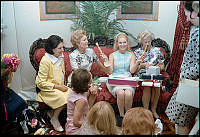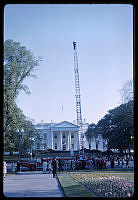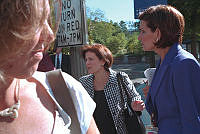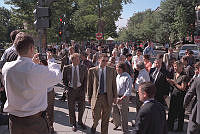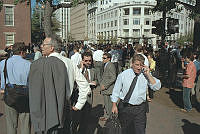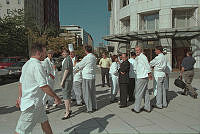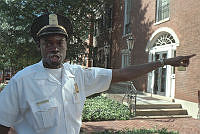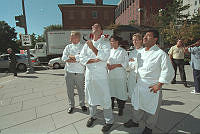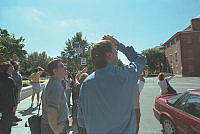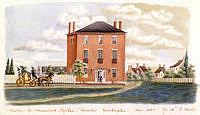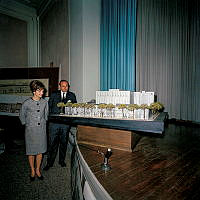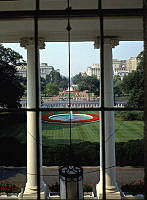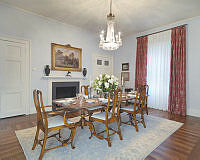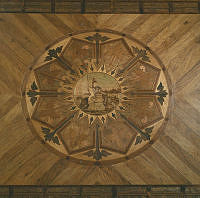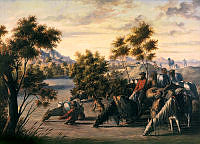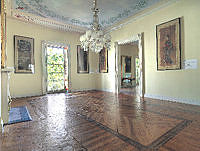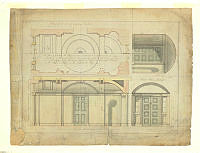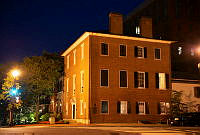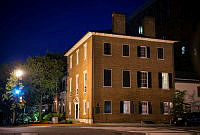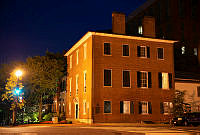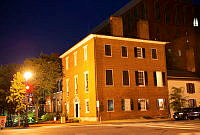Rubenstein Center Scholarship
Ulysses S. Grant's Cabinet
On March 4, 1869, Ulysses S. Grant took the oath of office and became the eighteenth President of the United States. His inauguration was a joyful occasion—many Americans celebrated Grant as the military hero that defeated the Confederacy. After Andrew Johnson’s dismal administration, Americans welcomed Grant’s election as an opportunity to restore the glory and honor of the presidency.
The Grants viewed their arrival at the White House as a new beginning as well. After the war years and Johnson’s turbulent presidency, the Executive Mansion was in desperate need of repairs and redecoration. Julia Grant ordered new wallpaper and installed carpets before the Grants moved into the White House in mid-March.1 That summer, they vacationed on Long Island and used their time away to begin more significant renovations. The Grants hired the New York firm Pottier & Stymus to oversee the design and Mr. Stymus traveled to Washington, D.C. to supervise the work himself.2

President Grant’s cabinet pictured in Harper’s Weekly.
Harper’s Weekly, April 3, 1869.One of the first spaces slated for redesign was the suite of rooms toward the southeast corner reserved for the president’s office, the cabinet room, and the clerks’ rooms. Andrew Johnson had moved the cabinet’s meeting space one room to the west (from today’s Lincoln Bedroom to the Treaty Room) and Grant maintained this layout. Pottier & Stymus selected a light yellow tone for the walls, and hung tapestry and lace curtains that looped back to the windows. Pictures taken during later administrations suggest the carpet was replaced as well.3

Pottier & Stymus also ordered new furniture for the president’s office. The centerpiece of the Cabinet Room was a long table with eight locking drawers, one for each member of the president’s cabinet. The drawers provided secure spaces for each secretary to leave state papers, without worrying they might be read by clerks or household staff. Stymus also purchased a suite of French walnut furniture, including a sofa with the United States shield carved on the crest, ten stuffed back chairs, and four armchairs—all upholstered in dark green tapestry. The secretaries likely pulled these stuffed back chairs around the table during meetings, while the sofa and the extra seats remained along the walls.
The final bill for the renovation listed “1 Revolving chair, 1 Rack, 1 Patent Revolving Secretary…1 Gilt Mantelframe/Best French plate, 2 Window Cornices, 2 Sets Draw’g Curtains with draperies.” To complete the room, they selected a fire screen, a walnut side table, a seven-foot chandelier, wall brackets with globes, and a Rose du Var marble mantel. Finally, they acquired an unusual black marble and malachite clock for the mantel. The clock was made in France and sold by Browne & Spaulding Co., a New York company, in 1869. It has three dials: a clock, perpetual calendar, and a barometer, plus a thermometer.4

This photo shows the residential neighborhood near 15th and F Streets. Similar homes extended up to I Street, where Secretary of State Hamilton Fish lived.
Library of CongressMuch of this extraordinary furniture survives in the White House collection. The cabinet table often serves as a desk in the Treaty Room and several presidents have signed important treaties and peace accords on its surface. A few examples include the peace protocol that ended the Spanish-American War (1898), the Kellogg-Briand Peace Pact (1929), and several Middle Eastern peace accords.5
The cabinet was an integral part of the president’s daily life in the White House. Grant usually woke at seven, ate breakfast, and took a daily walk around Washington, D.C. before arriving at his office at ten o’clock. For the next five hours, he efficiently dispatched his work: meeting with his cabinet, reading papers, greeting visitors, and delegating issues to his various secretaries. Cabinet meetings typically took place on Thursdays and Fridays, and the secretaries gathered around the large table.6 On days when no cabinet meeting was scheduled, Grant sometimes walked across Pennsylvania Avenue and Lafayette Square to Secretary of State Hamilton Fish’s home on the corner of 15th and I Streets to discuss foreign policy.7

This photograph of the Treaty Room was taken in March 1979 by National Geographic photographer Joseph H. Bailey. The Treaty Room is located on the Second Floor of the White House and is used as the presidents private study where the commander-in-chief can analyze reports, hold private meetings, edit speeches, and host family gatherings. It is one of the most historic rooms in the house, bearing witness to the signing of the peace protocol between Spain and United States in 1898, the Limited Nuclear Test Ban between the United States and the Soviet Union in 1963, and is possibly where President James Monroe composed the Monroe Doctrine. It has also served as the Cabinet Room for various administrations including for presidents Ulysses S. Grant, Rutherford B. Hayes, and William McKinley.
White House Historical AssociationAround three in the afternoon, the end of the workday, Grant sometimes walked down the back staircase of the White House out to the stables to greet his beloved horses. After riding for a few hours, Grant joined his family for an early dinner at five o’clock. After the children went to bed, the president and first lady hosted friends, cabinet secretaries and their wives, and visiting dignitaries most evenings in the Red Room. Other nights, they took their carriage to the nearby homes of cabinet secretaries to enjoy their company.8
Grant’s workspace and his daily schedule suggests he adopted a leadership style similar to the one he used as Lieutenant General of the Union army. First, he trusted his own judgment. He selected his cabinet appointments without consulting anyone—not party leaders, not his friends, not his wife.9 He selected secretaries from all wings of the Republican Party, relying on personal connections rather than shared partisan ideology.

This armchair was purchased during the Grant Administration and used in the Cabinet Room until 1902 when it was sold during the Theodore Roosevelt Renovation. Until the construction of the West Wing in 1902, the Cabinet Room was on the east end, second floor of the Executive Mansion. The chair was returned to the collection in 1962.
White House Historical Association/White House CollectionSecond, he gathered around him a close group of clerks and secretaries whom he trusted completely, and to whom he was intensely loyal. While his intuition led him to many exceptional choices, including Fish as secretary of state, his loyalty to former colleagues also brought him misfortune. For example, Grant selected his friend, Alexander Stewart, to serve as the secretary of the treasury because he was the richest man in America and could bring valuable trade experience to bolster the nation’s post-war economy. But many observers saw the nomination as a corrupt bargain of sorts because Stewart had purchased a home for Grant during the campaign.10
Third, he delegated responsibility and gave his subordinates significant authority to manage their portfolios. This trust was often rewarded—at Grant’s instruction, Secretary of the Treasury George Boutwell managed to reduce the national debt by $12 million in two months. Other times, Grant was too trusting of friends and colleagues.11 Abel Rathbone Corbin, Grant’s brother-in-law, worked with financiers Jay Gould and James Fisk to take advantage of Grant’s connections to corner the gold market. Only last-minute action by Grant and Boutwell prevented the total collapse of the economy.12

This portrait photograph by Frances Benjamin Johnston shows President William McKinley standing by his desk in the Treaty Room. The Treaty Room, also historically called the Cabinet Room, is located in the Second Floor residence of the Executive Mansion. The desk behind McKinley was acquired during the Ulysses S. Grant administration and historically resides there in the room's contemporary use as the president's private study. Johnston was one of the earliest female photographers and photojournalists, and had her own studio in Washington, D.C.
Library of CongressFinally, like many successful presidents before him, Grant knew his own limitations. He sought advisors with more experience and expertise, and then relied on their advice.13 While he was well-acquainted with military affairs, diplomacy provided a new challenge. In the first year of his administration, Grant spent most of his time in cabinet meetings listening and absorbing information. In March and April 1871, Grant gave Fish full rein to negotiate a new treaty with Great Britain. Each evening, Grant strolled over to Fish’s home to discuss the day’s deliberations. This productive relationship produced the Treaty of Washington on May 8, 1871, which settled on lingering disagreements between the two nations from the American Revolution and the Civil War.14

This black marble and malachite mantel clock has three dials (clock, calendar, and barometer) and a thermometer and was made in France. It was purchased from retailer Browne & Spaulding of New York City for the mantelpiece in the Ulysses S. Grant administration Cabinet Room. Until the construction of the West Wing in 1902, the Cabinet Room was on the east end of the second floor in the Executive Mansion.
White House Historical Association/White House CollectionGrant also relied on local officials and allies to help manage the administration’s fight against the Ku Klux Klan. In 1870, Grant appointed Amos T. Akerman as the new attorney general to oversee the recently created Department of Justice. Akerman had worked as a teacher in North Carolina and Georgia before passing the bar in 1850. After the Civil War, he helped organize the Republican Party in Georgia and supported black politicians in the Georgia state legislature. Grant also tapped Benjamin H. Bristow, another southern Republican, to be the first solicitor general. As the U.S. attorney for Kentucky, Bristow used the new Civil Rights Act of 1866 to prosecute individuals who committed crimes against African Americans. Grant instructed Bristow to pursue similar lawsuits through the Department of Justice on behalf of the federal government. The president also counted on Akerman and Bristow’s support when he sent troops to South Carolina to suspend the writ of habeas corpus and conduct widespread arrests of suspected Klan members. Their local knowledge was indispensable, especially as other cabinet members opposed military action.15

This walnut conference table by Pottier & Stymus Manufacturing Co. of New York has eight locking drawers, one for each member of the Cabinet in 1869. Several international treaties and agreements were signed on this table.
White House Historical Association/White House CollectionBristow’s next position demonstrated both the promise and peril of Grant’s trust and loyalty for his subordinates. In the 1870s, whiskey distillers underreported their output to reduce their tax payments, defrauding the federal government out of millions of dollars in tax revenue. While distillers had employed this strategy for decades, by Grant’s second term it was a poorly kept secret. In recognition of Bristow’s exceptional service as the Solicitor General, Grant appointed him as the new secretary of the treasury and ordered him to root out corruption. Bristow proved that Grant’s trust was well-placed, as he cracked down on whiskey rings across the country and tracked the conspirators all the way back to the White House. He discovered that Orville Babcock, Grant’s private secretary, had been leaking information to associates in St. Louis to help them avoid arrest. Grant encouraged Bristow to pursue all leads, while maintaining Babcock’s innocence and testifying on his behalf at trial. Although Babcock was acquitted, Grant no longer had the same faith in his old friend and removed him from office. In Babcock’s place, he appointed his son, Ulysses S. Grant, Jr.—a secretary he could trust completely.16

This oversize Renaissance Revival walnut sofa is part of a suite made by Pottier Stymus Manufacturing Co. of New York for President Ulysses Grant's Cabinet Room in 1869. A shield, likely inspired by the shield from the Great Seal of the United States, is carved on the crest. Unlike the shield on the official seal, this shield has three five-pointed stars carved into the chief. Until the construction of the West Wing in 1902, the Cabinet Room was on the east end of the second floor in the Executive Mansion.
White House Historical Association/White House CollectionGrant’s experience with Babcock was just the tip of the iceberg when it came to corruption and kickbacks. President Andrew Jackson had created the spoils system—a system of rewards and appointments that presidents doled out to their supporters in return for election assistance. This patronage system fostered the growth of bribes and fraud in government service. While Grant tried to reform civil service by supporting the creation of the United States Civil Service Commission, which would select employees based on merit. In 1874, just a few years after its creation, Congress refused to allocate funding for the Commission in order to protect its share of the spoils system.17

These walnut armchairs are part of a suite made by Pottier and Stymus Manufacturing Co. of New York for President Ulysses Grant's Cabinet Room in 1869. Until the construction of the West Wing in 1902, the Cabinet Room was on the east end of the second floor in the Executive Mansion.
White House Historical Association/White House CollectionEven when they disagreed with his final decision, Grant won the respect of his cabinet secretaries. Boutwell wrote, “He expressed his opinions with the greatest freedom, and upon discussion, he often yielded to the suggestions or arguments of others. He was so great that it was not a humiliation to acknowledge a change in opinion, or to admit an error in policy or purpose.” Postmaster General John A.J. Creswell agreed: “Grant is so good and pure that all he needs for his perfect vindication is simply that the people know him and his works. The more I see of him the more devotedly do I admire and love him.”18 While history has remembered Grant’s presidency with mixed results, his cabinet leadership inspired devotion from his subordinates.













